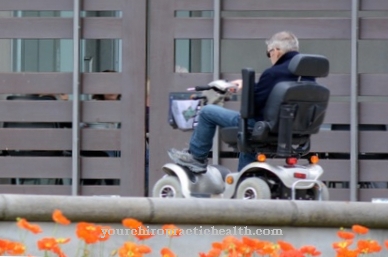Varifocal contact lenses have a similar benefit for contact lens wearers as varifocals do for spectacle wearers: They enable sharp vision at close range and at a distance using the same medium. The visual aids, which have been continuously developed from a technical point of view, now offer the same level of comfort as other contact lenses.
What are varifocal contact lenses?

Varifocal contact lenses are also available multifocal contact lenses or Multifocal contact lenses called. They help to correct age-related ametropia and another ametropia (nearsightedness or farsightedness).
The special contact lenses are similar to bifocal glasses, with the difference that there are two types of manufacture. With the multifocal contact lenses, the presbyopic patient can not only replace varifocals, but also glasses for distance vision and those for close range (reading glasses).
The special contact lenses - if they are optimally adapted to the special needs of their user - have the same advantages as other contact lenses. They can be worn for a long time, have a good fit and are more practical than glasses because, unlike these, they do not restrict the user's field of vision. They swim invisibly on the tear film of the cornea, do not restrict freedom of movement during sports and do not change the face.
With high-quality multifocal contact lenses, the quality of vision is almost equivalent to that of natural vision. Like other contact lenses, age-correcting contact lenses adapt optimally to the curvature of the cornea. In addition, they follow every eye movement so that they are usually not perceived as annoying.
Shapes, types & types
There are two types of manufacture of multifocal contact lenses: alternating (segment-shaped) and simultaneous (bivisual or concentric) varifocal contact lenses. The alternating lenses are basically similar to varifocals. The upper viewing area is suitable for distance vision, the lower area for near vision. The initially clearly noticeable demarcation between the two visual acuities is no longer perceived after a long period of acclimatization.
With bivisual varifocal contact lenses, the two prescriptions are on different concentric rings. They ensure that the two areas of vision are displayed on the retina at the same time (hence the name simultaneous multifocal contact lenses). These contact lenses have the advantage over the alternate ones that the wearer has a slightly shorter time to get used to them. The brain adapts to the changed way of seeing: It selects the appropriate near or far image and at the same time suppresses the undesired other.
Multifocal contact lenses are available as soft or hard contact lenses, daily, weekly or monthly contact lenses and for special requirements. Alternating multifocal contact lenses are hard contact lenses, while simultaneous ones are manufactured as soft contact lenses. As hard contact lenses, they are more permeable to oxygen and can be worn longer every day. They enable sharper vision than soft contact lenses and are not as prone to inflammatory reactions in the eye.
In the form of soft contact lenses, they are more comfortable to wear because they adapt to the cornea better than hard multifocal contact lenses. They are therefore particularly suitable for patients with sensitive eyes. Users with insufficient tear fluid and people whose eyes are not adequately supplied with oxygen use them as silicone hydrogel contact lenses. For people with astigmatism, varifocal contact lenses are custom-made in the form of hard and soft contact lenses.
Structure & functionality
Multifocal contact lenses each have two fields of vision with two different levels of vision: one for near vision and one for distant vision. There is also an intermediate zone for recognizing objects that are in the middle of the distance. Where the areas are located on the contact lens depends on whether it is alternating or bivisual.
With the alternating multi-focus contact lenses, the near and far areas are clearly demarcated from each other: with the upper part of the contact lens, which is exactly on the pupil, the user can clearly see objects in the distance, with the lower part, objects in the vicinity. By moving the eyes when looking down, the contact lens is aligned so that the user looks through the lower part (near vision area).
With the bivisual varifocal contact lens, the near area is in the center of the contact lens and lies on the pupil. Around it, on a larger concentric circle, lie the area for medium distances (intermediate zone) and around it the far area. If the patient sees an object nearby, the pupils contract and the entire outer area of the contact lens is masked out by the restricted incidence of light (due to the pupil reflex).
Although the bivisual multifocal lenses are more comfortable to wear than soft contact lenses for the user, they cannot compensate for all ametropia: The user should under no circumstances wear them when driving at night. Long periods of reading and working on the computer are often so stressful for the brain that it gets headaches or tires more quickly.
You can find your medication here
➔ Medicines for visual disturbances and eye complaintsMedical & health benefits
Multifocal contact lenses restore normal vision in age-related ametropia patients. Since the presbyopia that occurs in most people from the age of 45, unlike other ametropia, cannot be corrected using laser surgery, the only option left for the patient is to purchase varifocals or to use reading glasses as a supplement. In the case of presbyopia, degenerative changes cause the eye to lose its natural ability to adapt closely (accommodation). For example, objects that the patient previously recognized clearly at a distance of 10 cm can only be recognized precisely at a distance of 38.5 cm.
In addition to restoring vision, multifocal contact lenses offer their users many advantages that are essentially the same as those of normal contact lenses. The benefits are clearly noticeable, for example, when doing high-activity work, exercising or swimming.




























